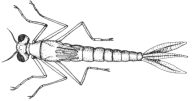INCOMPLETE
COMPLETE
Egg
Egg
![]()
![]()
![]()
![]()
Nymph
Larva
![]()
![]()

(numerous growth instars)
![]()
![]()
![]() (numerous growth instars)
(numerous growth instars)
![]()
Pupa
![]()

![]()
Adult
Adult

![]()
| Map | FAQ |
Flyfishing Entomology |
|
Aquatic Insect Metamorphic Life Stages |
|
INCOMPLETE |
COMPLETE |
|
|
|
|
Egg |
Egg |
|
|
|
|
|
|
|
Nymph |
Larva |
|
|
|
|
|
|
|
|
Pupa |
|
|
|
|
|
|
|
Adult |
Adult |
|
|
|
| Metamorphosis Depending on insect order, aquatic insects undergo either incomplete or complete metamorphosis. Incomplete The life stages of insects undergoing incomplete metamorphosis are egg, nymph, and adult. The initial (egg) life stage begins when an adult female oviposits eggs. The egg generally finds its way to the bottom of a body of water, either by gravity or actual placement, where it becomes attached to the substrate and begins a period of growth and development. The length of this period is generally 1-2 weeks. The 2nd (nymphal) life stage begins when the immature nymph escapes its egg, and begins actively feeding and growing. Having the limitation of an external skeleton, which won't accommodate much growth, this exoskeleton must be periodically shed, and another larger one formed. This process is called molting. The period between molts is called an instar. The number of nymphal instars can vary from 8 to 30 (or more) for different insect orders. The nymphal period can vary from several months to as long as 2 or 3 years for some large aquatic insects. The 3rd (adult) life stage commences with a mature larva transforming into a winged adult form. The exception to this is mayflies, which first transform into a winged (sexually-immature) adult form called a dun (subimago), and shortly thereafter transform into a winged (sexually-mature) adult form called a spinner (imago). Among aquatic insects sharing incomplete metamorphosis are mayflies, damselflies, dragonflies, stoneflies, and waterbugs. Complete Metamorphosis The life stages of insects undergoing complete metamorphosis are egg, larva, pupa, and adult. The initial (egg) life stage is the same as described above under incomplete metamorphosis. The 2nd (larval) life stage begins when the immature larva escapes its egg, and begins actively feeding and growing. Larvae undergo the same molting process as described for nymphs. The number of larval instars can vary from 3 to 11 for different insect orders. The nymphal period is a short as a single week for some true fly families, but is as long as a year or more for others .The larva pictured here is of a chironomid, a type of true fly, which doesn’t have an obvious head or jointed legs, and looks rather worm-like. However, larvae of most orders (of aquatic insects undergoing complete metamorphosis) do have an obvious head and jointed legs, therefore don't look nearly so worm-like. The 3rd (pupal) life stage begins when the mature larva transforms into a pupa. A terrestrial insect example of pupation is the caterpillar, which seals itself in a cocoon to pupate prior to emerging as a butterfly. The 4th (adult) life stage begins when the pupa undergoes metamorphosis and transforms into a winged adult. Among aquatic insects sharing complete metamorphosis are alderflies, dobsonflies, beetles, moths, caddisflies, and true flies. |
Created: 08/04/2004 Last modified: 06/02/2008 www.FlyfishingEntomology.com